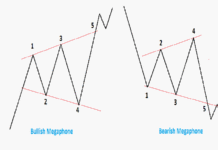
The US Dollar Index (USDX) is a widely recognized financial instrument used to measure the performance of the United States dollar (USD) against a basket of six major world currencies. It provides a relative strength assessment of the US dollar in comparison to these other currencies. The six major currencies included in the index and their respective weightings are as follows:
- Euro (EUR): 57.6% weighting
- Japanese Yen (JPY): 13.6% weighting
- British Pound Sterling (GBP): 11.9% weighting
- Canadian Dollar (CAD): 9.1% weighting
- Swedish Krona (SEK): 4.2% weighting
- Swiss Franc (CHF): 3.6% weighting
The US Dollar Index is primarily used by traders, investors, and central banks as a tool to gauge the overall strength or weakness of the U.S. dollar relative to its major trading partners. Here are some key points about the USDX:
Formula:
The USDX is calculated using a geometric weighted mean formula. It compares the USD’s value to a base period, which is currently set at 100. When the index is above 100, it indicates that the USD has strengthened relative to the base period, and when it’s below 100, it suggests that the USD has weakened.
Purpose:
The primary purpose of the US Dollar Index is to provide a benchmark for traders and investors to track the dollar’s performance in the global foreign exchange (forex) market. It helps in assessing trends and making trading decisions.
Inverse Relationship:
The USDX tends to have an inverse relationship with other major currencies in the basket. When the U.S. dollar strengthens, the index rises, and when the dollar weakens, the index falls.
Forex Trading:
Forex traders often use the US Dollar Index as a tool for technical analysis and trend identification. For example, if the USDX is rising, it may suggest that the USD is strengthening against the basket of currencies, potentially leading traders to consider long (buy) positions in USD pairs.
Economic Indicator:
Some investors and analysts also use the US Dollar Index as a leading economic indicator. A rising USDX might be interpreted as a sign of confidence in the US economy, while a falling index could indicate economic concerns.
Limitations:
It’s important to note that the US Dollar Index only includes six major currencies and does not represent the entire universe of currencies. Additionally, market dynamics can be influenced by factors other than the USDX, including geopolitical events, economic data releases, and central bank policies.
Traders and investors should use the US Dollar Index as one of many tools in their analysis and decision-making processes when participating in the foreign exchange markets or trading currency-related instruments.
Related Articles:
Six Fundamental Indicators to Use When Trading Stocks




























